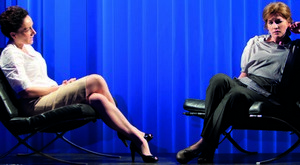SITE GUIDE
SEARCH
REVIEWS
REVIEW ARCHIVES
ADVERTISING AT CURTAINUP
FEATURES
NEWS
Etcetera and
Short Term Listings
LISTINGS
Broadway
Off-Broadway
NYC Restaurants
BOOKS and CDs
OTHER PLACES
Berkshires
London
California
New Jersey
DC
Philadelphia
Elsewhere
QUOTES
TKTS
PLAYWRIGHTS' ALBUMS
LETTERS TO EDITOR
FILM
LINKS
MISCELLANEOUS
Free Updates
Masthead
Writing for Us
A CurtainUp  London Review
London Review
 London Review
London ReviewSpeaking In Tongues
|
It maps an emotional landscape typified by a sense of disconnection and a shifting moral code.— Andrew Bovell on Speaking in Tongues
|

Lucy Cohu and Kerry Fox (Photo: Johan Persson)
|
The kaleidoscopic view of human relations contains four actors tackling nine parts of characters. They interact and overlap but never fully connect, with a chain of stories linked by coincidences, chance meetings and an overall sense of isolation. Whilst the characters express themselves with lucid articulation, they never connect fully with each otherís subjective sense of reality and thus never "speak the same language".
Although the cast are a top selling point of the production and individually, are expert , fascinating actors, they rarely gel together as a coherent whole. This is to some degree a simple reflection of the playís core theme of disconnection: they dance and tiptoe around each other, missing each other both verbally and emotionally. However, Toby Frowís uninspired direction never cracks this sense of lonely dislocation and instead produces an experience difficult for audience to engage with. Wrenched from one characterís discrete reality to anotherís , this is a complex, elusive and ultimately exhausting production to watch.
Within this emotional disarray, the actors themselves are compelling and convincing. Kerry Fox turns from dowdy, unhappy wife into a brittle, insecure "other woman" and serial abandoner of men with fluent adeptness. John Simm plays the adulterous detective Leon and the rather less salubrious Nick, whilst Ian Hart shifts from tortured, unhappy husband to a man suffering from years of unrequited love and then an unfaithful but self-justifying husband. And finally Lucy Cohu plays both a wife tempted into infidelity and a psychologist whose own fragility overshadows her professional advice. Although thoroughly accomplished performances, the unreconciled strands of characters create a production which is more a showcase for the actorsí talents and versatility than an affecting and effective whole.
This Speaking In Tongues has a sleek, contemporary design by Ben Stones. From anonymous modernity to the natural world of terrifying magnitude , the design echoes the textís journey across the two halves. Whilst the pre-interval half is based in bars, seedy hotel rooms and bland metropolitan living spaces, the second half moves into deeper psychological geography, with colossal forest, cliff edges and the therapistís couch, all in an unspecific, "anywhere" setting. Video projection with over-sized Blair Witch style shots plays with the textís cinematic elements but cannot disguise the castís clunky, awkward movement on stage.
Thick in a glossy but forgettable style, this production really needs a deeper engagement with the playís intellectual basis. Andrew Bovellís dense and demanding text requires impeccable direction to be translated successfully onto the stage. The precise but labyrinthine nexus of relationships covering love, loss and betrayal is undermined by heavy-handed, overblown direction which not even unimpeachable performances can utterly negate.
|
Speaking In Tongues
Written by Andrew Bovell Directed by Toby Frow With: John Simm, Ian Hart, Kerry Fox, Lucy Cohu Design by Ben Stones Lighting Design by Johanna Town Video and Projection Design by Lorna Heavey Music and Sound Design by: Richard Hammarton Running time: Two hours 10 minutes with one interval Box Office: 0844 871 7627 Booking to: 12 December 2009 Reviewed by Cassie Robinson based on 29 September 2009 performance at The Duke of Yorkís Theatre, St Martins Lane, London, WC2N 4BG (Tube: Leicester Square) |
|
REVIEW FEEDBACK Highlight one of the responses below and click "copy" or"CTRL+C"
Paste the highlighted text into the subject line (CTRL+ V): Feel free to add detailed comments in the body of the email and state if you'd like your comments published in our letters section. |
|
London Theatre Tickets Lion King Tickets Billy Elliot Tickets Mighty Boosh Tickets Mamma Mia Tickets We Will Rock You Tickets Theatre Tickets |




